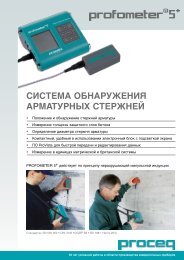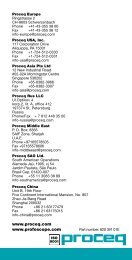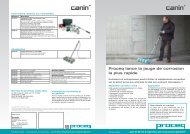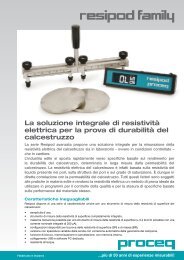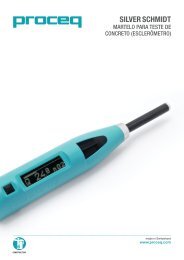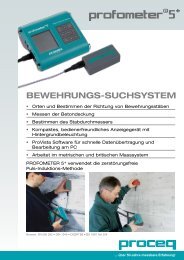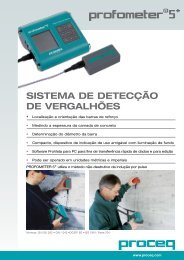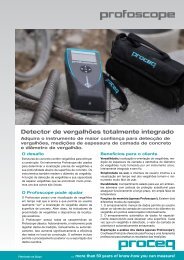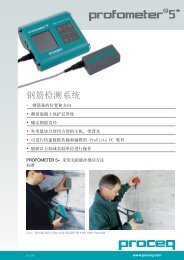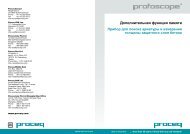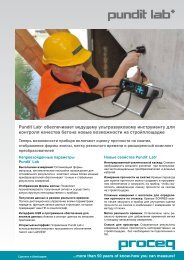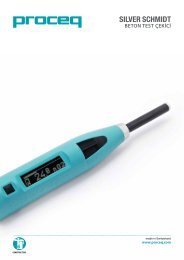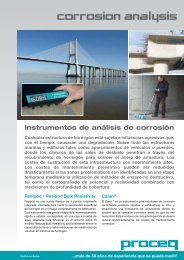Pundit Lab/Lab+ Remote Control Interface - Proceq
Pundit Lab/Lab+ Remote Control Interface - Proceq
Pundit Lab/Lab+ Remote Control Interface - Proceq
Create successful ePaper yourself
Turn your PDF publications into a flip-book with our unique Google optimized e-Paper software.
<strong>Pundit</strong> <strong>Lab</strong>/<strong>Lab</strong>+ <strong>Remote</strong> <strong>Control</strong> <strong>Interface</strong><br />
Documentation<br />
Document Revision: 3<br />
Revision Date: 20-July-2011
Revision History<br />
Rev Date Comments<br />
1 02-March-2010 pre-released for review<br />
2 12-April-2010 Detailed description of serial interface related issues, data<br />
structures and individual commands<br />
3 20-July-2011 Fixed some inconsistencies in data structures and remote<br />
command descriptions.<br />
Additional probe frequency of 250kHz (>V1.2.4)<br />
<strong>Pundit</strong> <strong>Lab</strong>+:<br />
Data structure for conversion curves added (TConvCurve)<br />
Measurement and device setup data adapted accordingly.<br />
New probe gain levels for <strong>Pundit</strong> <strong>Lab</strong>+<br />
4 24-October-2011 SET_DEVICE_SETUP: Description of command, response<br />
and example corrected and clarified (two responses, no CRC)<br />
Table of Contents<br />
<strong>Pundit</strong> <strong>Lab</strong>/<strong>Lab</strong>+ <strong>Remote</strong> <strong>Control</strong> <strong>Interface</strong> ............................................................................ 1<br />
Documentation ......................................................................................................................... 1<br />
1. Introduction ........................................................................................................................... 3<br />
1.1 Scope / intended use ....................................................................................................................... 3<br />
1.2 Boundary conditions ........................................................................................................................ 3<br />
1.3 Abbreviations ................................................................................................................................... 3<br />
2. Overview ............................................................................................................................... 4<br />
2.1 Purpose ........................................................................................................................................... 4<br />
2.2 Notation ........................................................................................................................................... 4<br />
2.3 Requirements, prerequisites, limitations ......................................................................................... 4<br />
2.4 Suggestions, bugs, improvements .................................................................................................. 4<br />
3. Serial interface ...................................................................................................................... 5<br />
3.1 Virtual COM port driver .................................................................................................................... 5<br />
3.2 Serial <strong>Interface</strong> parameters ............................................................................................................. 5<br />
3.3 Detect <strong>Pundit</strong> <strong>Lab</strong>/<strong>Lab</strong>+ device ....................................................................................................... 5<br />
4. Data structures ..................................................................................................................... 6<br />
4.1 Data types ....................................................................................................................................... 6<br />
4.2 Conversion curves data (TConvCurve) ........................................................................................... 6<br />
4.3 Measurement data .......................................................................................................................... 7<br />
4.4 Device setup data ............................................................................................................................ 9<br />
4.5 Curve data ..................................................................................................................................... 11<br />
5. <strong>Remote</strong> commands description ......................................................................................... 12<br />
5.1 Overview........................................................................................................................................ 12<br />
5.2 Individual remote commands ........................................................................................................ 12
1. Introduction<br />
1.1 Scope / intended use<br />
This document describes the <strong>Pundit</strong> <strong>Lab</strong>/<strong>Lab</strong>+ remote control interface. It consists of a set of<br />
binary commands which allow the user to configure the <strong>Pundit</strong> <strong>Lab</strong>/<strong>Lab</strong>+ device, to trigger<br />
measurements and to collect measurement data using a remote PC.<br />
The target audience is software engineers and <strong>Proceq</strong> customers who want to embed <strong>Pundit</strong><br />
<strong>Lab</strong>/<strong>Lab</strong>+ remote functionality into their own PC applications.<br />
1.2 Boundary conditions<br />
This document relies on the <strong>Pundit</strong> <strong>Lab</strong>/<strong>Lab</strong>+ Firmware Version V2.0.4 but is also valid for older<br />
versions. For further conditions see [2.3 Requirements, prerequisites].<br />
1.3 Abbreviations<br />
3<br />
Term Description<br />
USB Universal serial bus<br />
UART Universal Asynchronous Receiver Transmitter<br />
PL <strong>Pundit</strong> <strong>Lab</strong><br />
PLP <strong>Pundit</strong> <strong>Lab</strong>+
2. Overview<br />
2.1 Purpose<br />
The purpose of this document is to describe all necessary interface facts to enable customers to<br />
use the <strong>Pundit</strong> <strong>Lab</strong>/<strong>Lab</strong>+ device in a most flexible way according to their needs. Possible<br />
applications are:<br />
• Integration of <strong>Pundit</strong> <strong>Lab</strong>/<strong>Lab</strong>+ into a (semi-) automated production line.<br />
• <strong>Control</strong>ling <strong>Pundit</strong> <strong>Lab</strong>/<strong>Lab</strong>+ and collecting measurement data from the device using own<br />
software and databases to be further processed or stored without the need of the <strong>Pundit</strong><br />
Link software and the overhead of unneeded manual work.<br />
• <strong>Remote</strong> setup of <strong>Pundit</strong> <strong>Lab</strong>/<strong>Lab</strong>+ into a specific, well defined measurement mode with<br />
one click.<br />
2.2 Notation<br />
The different functions can be started through remote commands described later in this<br />
document. The description of the individual commands is based on the following rules:<br />
Each command consists of a defined number of bytes. These bytes are always described in<br />
hexadecimal syntax (e.g. 0x12 = 18 decimal).<br />
Variable byte-values within a command are described by replacements characters (e.g.: PP).<br />
For number values with two bytes the low-order byte is presented by lower-case letters and the<br />
high-order byte by upper-case letters (e.g.: pp PP).<br />
For number values with more than two bytes a number is added to the replacement characters.<br />
Numbering starts with 0, which represents the low-order byte (e.g.: ZZ0 ZZ1 ZZ2).<br />
2.3 Requirements, prerequisites, limitations<br />
To avoid problems during remote connection please take care of the following:<br />
• Make sure the <strong>Pundit</strong> <strong>Lab</strong>/<strong>Lab</strong>+ is powered and connected to the PC<br />
• Do not disconnect the <strong>Pundit</strong> <strong>Lab</strong>/<strong>Lab</strong>+ while communication with the PC is active<br />
• Do not try to start/stop measurements locally by pressing any <strong>Pundit</strong> <strong>Lab</strong>/<strong>Lab</strong>+ button<br />
while measurements are being triggered remotely from a PC.<br />
2.4 Suggestions, bugs, improvements<br />
We hope that with this solution we can fulfill most customer needs regarding the matter of<br />
automation and remote control of <strong>Pundit</strong> <strong>Lab</strong>/<strong>Lab</strong>+.<br />
Should there be any bugs, missing commands, questions and other suggestions regarding this<br />
add-on, please feel free to write an email to: software@proceq.com<br />
We appreciate your feedback and we will gather any incoming information and try to help<br />
whenever possible.<br />
4
3. Serial interface<br />
3.1 Virtual COM port driver<br />
The <strong>Pundit</strong> <strong>Lab</strong>/<strong>Lab</strong>+ offers a USB UART interface by which it can be remotely controlled from a<br />
PC. I.e. physically, the device appears like a normal USB device, but internally the <strong>Pundit</strong> <strong>Lab</strong>/<br />
<strong>Lab</strong>+ uses a UART, which is an asynchronous, serial interface (similar to RS232). A so called<br />
USB bridge device on the <strong>Pundit</strong> <strong>Lab</strong>/<strong>Lab</strong>+ makes the conversion from UART to USB signals<br />
and vice versa.<br />
On the PC side it is necessary to install a virtual COM port driver, which causes the <strong>Pundit</strong><br />
<strong>Lab</strong>/<strong>Lab</strong>+ to appear as if it was connected to a standard serial COM port to the PC. This allows<br />
application software running on the PC to access the <strong>Pundit</strong> <strong>Lab</strong>/<strong>Lab</strong>+ in the same way as it<br />
would access a standard COM port.<br />
To install the virtual COM port driver you can either:<br />
• Get and install <strong>Proceq</strong>’s <strong>Pundit</strong> Link software. The virtual COM port driver is installed<br />
automatically.<br />
or:<br />
• Get the virtual COM port driver setup program from FTDI’s home page<br />
(http://www.ftdichip.com/Drivers/VCP.htm)<br />
Provided that the PC has an active internet connection, some newer versions of the Windows<br />
operating system (XP, Vista and 7) automatically get and install the needed driver when the<br />
USB device is connected.<br />
3.2 Serial <strong>Interface</strong> parameters<br />
To be able to communicate to the <strong>Pundit</strong> <strong>Lab</strong>/<strong>Lab</strong>+ device, the following serial interface<br />
parameters must be set:<br />
• 115200 baud<br />
• 8 data bit<br />
• 1 stop bit<br />
• No parity<br />
3.3 Detect <strong>Pundit</strong> <strong>Lab</strong>/<strong>Lab</strong>+ device<br />
When the <strong>Pundit</strong> <strong>Lab</strong>/<strong>Lab</strong>+ device is connected to a PC, the Windows operating system<br />
automatically assigns the next available COM port number. To find the correct COM port from<br />
within an application program, it is best to scan the COM ports starting at COM1, COM2, and so<br />
on. By sending the GET_DEVICE_INFO command (with sub-command 0x00 for device name<br />
and 0x04 for device signature) it’s possible to see if the <strong>Pundit</strong> <strong>Lab</strong>/<strong>Lab</strong>+ is connected to that<br />
particular port.<br />
Once connected, all of the remote commands described in this document can be sent to the<br />
<strong>Pundit</strong> <strong>Lab</strong>/<strong>Lab</strong>+.<br />
5
4. Data structures<br />
4.1 Data types<br />
The following table lists the types used to characterize data exchanged between the <strong>Pundit</strong><br />
<strong>Lab</strong>/<strong>Lab</strong>+ and a remote PC.<br />
Type specifier Description<br />
INT8U Unsigned integral type with a size of 1 byte<br />
INT8S Signed integral type with a size of 1 byte<br />
INT16U Unsigned integral type with a size of 2 bytes<br />
INT16S Signed integral type with a size of 2 bytes<br />
INT32U Unsigned integral type with a size of 4 bytes<br />
INT32S Signed integral type with a size of 4 bytes<br />
INT64U Unsigned integral type with a size of 8 bytes<br />
INT64S Signed integral type with a size of 8 bytes<br />
4.2 Conversion curves data (TConvCurve)<br />
Conversion curves for compressive strength calculation are only available for <strong>Pundit</strong> <strong>Lab</strong>+. The<br />
following table list the data bytes of such a conversion curve structure. It will be used in the<br />
measurement and device setup data structures described further down in this document.<br />
6<br />
Byte-Nr Structure Element Description Units / Range<br />
1 INT8U version Structure version 0x10<br />
2 INT8S curveType Conversion curve type<br />
-1 undefined<br />
0 polynomial ( ∗ + ∗ + ∗ + )<br />
1 exponential ( ∗ ∗ )<br />
2 SONREB ( ∗ ∗ )<br />
: Pulse velocity<br />
3…34 INT64S coeff[4] Array of 4 coefficients (, , , in the above equations),<br />
each of type INT64S<br />
35..36 INT16S min Lower limit of pulse velocity () [m/s]<br />
37..38 INT16S max Upper limit of pulse velocity () [m/s]<br />
37..49 INT8S name[11] Array of 11 characters specifying the name of the<br />
conversion curve. The 11 th character is the string (null-)<br />
terminator.
4.3 Measurement data<br />
The following table lists the sequential data bytes sent by <strong>Pundit</strong> <strong>Lab</strong>/<strong>Lab</strong>+ when a remote<br />
measurement is triggered. They are described in the order they are received on the remote PC.<br />
Extensions valid only for <strong>Pundit</strong> <strong>Lab</strong>+ are gray shaded in the table and marked with PLP.<br />
Structure size: <strong>Pundit</strong> <strong>Lab</strong>: 50 Bytes, <strong>Pundit</strong> <strong>Lab</strong>+: 109 Bytes<br />
7<br />
Byte-Nr Structure Element Description Units / Range<br />
1 INT8U version Structure version 0x10 (≤ V1.2.5)<br />
0x20 (≥ V2.0.4)<br />
2 INT8U measType Measurement type<br />
0 undefined<br />
1 direct measurement (default type in<br />
case of a remote controlled<br />
measurement)<br />
2 surface measurement<br />
3 crack measurement<br />
3…10 INT64U Reserved1 Reserved, always 0<br />
11…14 INT32U measId Measurement object id 0…0xFFFFFFFF<br />
15…16 INT16U corrFactor Correction factor (temperature, moisture, etc...) 1/100<br />
70…130<br />
(0.7…1.3)<br />
17…18 INT16U pulseLength Pulse length of transmitter trigger impulse 1/10 [µs]<br />
1…1000<br />
19 INT8S pulseAmpl Amplitude of transmitter trigger pulse<br />
-1 Undefined<br />
0 125 V<br />
1 250 V<br />
2 350 V<br />
3 500 V<br />
4 AUTO (automatic amplitude setting)<br />
20 INT8S probeFreq Resonance frequency of connected probes<br />
-1 Undefined<br />
0 24 kHz<br />
1 37 kHz<br />
2 54 kHz<br />
3 82 kHz<br />
4 150 kHz<br />
5 200 kHz<br />
6 220 kHz<br />
7 500 kHz (≤V1.2.4)<br />
7 250 kHz (>V1.2.4)<br />
8 500 kHz (>V1.2.4)<br />
21…24 INT32U measDistance Distance between measurement probes (i.e.<br />
path length). If propSpeed is given this value will<br />
be calculated as result of the measurement.<br />
(0.1…100.0µs)<br />
[V]<br />
[kHz]<br />
1/100 [mm]<br />
0…999999<br />
(0…9.99999m)<br />
25…28 INT32U crackDepth Crack depth [mm]<br />
0…9999<br />
29…32 INT32U propTime1 Propagation time 1 as the result of a<br />
measurement<br />
33…36 INT32U propTime2 Propagation time 2 as result of a measurement.<br />
For direct measurement this time is always 0.<br />
For surface velocity and crack measurement the<br />
value will be different from 0.<br />
37…40 INT32U propSpeed Propagation speed (pulse velocity)<br />
If measDistance is given this value will be<br />
calculated as result of the measurement<br />
(0…9.999m)<br />
1/100 [µs]<br />
0…999999<br />
(0…9999.99µs)<br />
1/100 [µs]<br />
0…999999<br />
(0…9999.99µs)<br />
1/100 [m/s]<br />
0…1000000<br />
(0…10000.00m/s)
8<br />
Byte-Nr Structure Element Description Units / Range<br />
41 INT8S rxProbeGain Receiver probe gain<br />
-1 Undefined<br />
0 1<br />
1 10<br />
2 100<br />
3 AUTO (automatic gain setting)<br />
<strong>Pundit</strong> <strong>Lab</strong>+:<br />
-1 Undefined<br />
5 1<br />
6 2<br />
7 5<br />
8 10<br />
9 20<br />
10 50<br />
11 100<br />
12 200<br />
13 500<br />
14 1000<br />
15 AUTO (automatic gain setting)<br />
42 INT8U result Type of calculated result<br />
1 calculated result is measDistance<br />
2 calculated result is propSpeed<br />
43…44 INT16S calibTimeOfs Calibration time offset<br />
45…46 INT16U pulseAmplValue Integral value of pulse amplitude (useful if<br />
pulseAmpl = AUTO)<br />
47…48 INT16U rxProbeGainValue Integral value of probe gain (useful if<br />
rxProbeGain = AUTO)<br />
49…50 INT16U nrOfCurveSamples Number of curve samples sent following this<br />
measurement data structure.<br />
Always 0 for measurements stored on <strong>Pundit</strong><br />
<strong>Lab</strong>/<strong>Lab</strong>+. Possibly ≠ 0 for remotely triggered<br />
measurements (see command<br />
TRIGGER_MEASUREMENT).<br />
51 INT8U reserved PLP: Undefined<br />
52…53 INT16S ambientTemp PLP: Ambient temperature (from temperature<br />
sensor of internal real-time-clock device)<br />
125…500<br />
PL: 1…100<br />
PLP: 1…1000<br />
0<br />
1/10 [°C]<br />
-1280…+1278<br />
(-128.0...127.8°C)<br />
54…57 INT32U compStrength PLP: Compressive strength 1/10 [MPa]<br />
58…106 TConvCurve curve PLP: Currently active conversion curve data<br />
structure according to TConvCurve.<br />
107…108 INT16U rebValue PLP: Currently active rebound value<br />
corresponding to the currently active conversion<br />
curve. The value is only valid if the conversion<br />
curve is of type SONREB.<br />
1/10<br />
0…1000<br />
(0…100.0)
4.4 Device setup data<br />
The following table lists the sequential data bytes sent by <strong>Pundit</strong> <strong>Lab</strong>/<strong>Lab</strong>+ when it’s setup is<br />
interrogated remotely. They are described in the order they are received on the remote PC.<br />
Extensions valid only for <strong>Pundit</strong> <strong>Lab</strong>+ are gray shaded in the table and marked with PLP.<br />
Structure size: <strong>Pundit</strong> <strong>Lab</strong>: 59 Bytes, <strong>Pundit</strong> <strong>Lab</strong>+: 322 Bytes<br />
9<br />
Byte-Nr Structure Element Description / Range Units / Range Note<br />
1 INT8U version Structure version<br />
0x10 (≤ V1.2.5)<br />
0x20 (≥ V2.0.4)<br />
4)<br />
2 INT8U reserved always 0 0 3)<br />
3…6 INT32U measId Current measurement object id.<br />
Incremented by <strong>Pundit</strong> <strong>Lab</strong>/<strong>Lab</strong>+ (see<br />
command TRIGGER_MEASUREMENT)<br />
4)<br />
7…10 INT32U nrOfStoredMeas Number of measurements stored on<br />
<strong>Pundit</strong> <strong>Lab</strong>/<strong>Lab</strong>+<br />
4)<br />
11…14 INT32U reserved Always 0 0 3)<br />
15…18 INT32U<br />
Preset measurement distance between<br />
1/100 [mm] 1)<br />
presetMeasDistance probes for direct measurement<br />
19…22 INT32U<br />
Preset measurement distance between<br />
1/100 [mm] 1)<br />
presetCrackDistance probes for crack measurement<br />
23…26 INT32U<br />
Preset measurement distance between<br />
1/100 [mm] 1)<br />
presetSurfaceDistance probes for surface velocity measurement<br />
27…28 INT16U corrFactor Correction factor (temperature, moisture,<br />
1/100<br />
etc.)<br />
70…130<br />
(0.7…1.3)<br />
29…32 INT32U calibTime Target calibration time. Should be same<br />
as on the calibration calibration stick.<br />
1/100 [µs] 1)<br />
33…34 INT16S calibTimeOfs Calibration time offset. Calculated during<br />
calibration, which is not possible to be<br />
done remotely.<br />
1/100 [µs] 1)<br />
35…36 INT16U pulseLength Pulse length of transmitter trigger pulse 1/10 [µs]<br />
37…40 INT32U reserved Always 0 0 3)<br />
41 INT8U lenUnit Length unit to be displayed on device<br />
2)<br />
0 m<br />
1 ft<br />
42 INT8S intRxProbeGain Receiver probe gain<br />
-1 Undefined<br />
0 1<br />
1 10<br />
2 100<br />
3 AUTO (automatic gain setting)<br />
<strong>Pundit</strong> <strong>Lab</strong>+:<br />
-1 Undefined<br />
5 1<br />
6 2<br />
7 5<br />
8 10<br />
9 20<br />
10 50<br />
11 100<br />
12 200<br />
13 500<br />
14 1000<br />
15 AUTO (automatic gain setting)<br />
43 INT8U reserved always 0<br />
3)
Byte-Nr Structure Element Description / Range Units / Range Note<br />
44 INT8S pulseAmpl Amplitude of transmitter trigger pulse<br />
[V]<br />
-1 Undefined<br />
0 125 V<br />
1 250 V<br />
2 350 V<br />
3 500 V<br />
4 AUTO (automatic ampl. setting)<br />
45 INT8S probeFreq Resonance frequency of connected<br />
probes<br />
[kHz]<br />
-1 Undefined<br />
0 24 kHz<br />
1 37 kHz<br />
2 54 kHz<br />
3 82 kHz<br />
4 150 kHz<br />
5 200 kHz<br />
6 220 kHz<br />
7 500 kHz (≤V1.2.4)<br />
7 250 kHz (>V1.2.4)<br />
8 500 kHz (>V1.2.4)<br />
46 INT8S measMode Measurement mode<br />
-1 Undefined<br />
0 Continuous Mode<br />
1 Burst Mode<br />
47…50 INT32U measDistance Distance between measurement probes 1/100 [mm]<br />
If setup data is set by means of the<br />
0…999999<br />
appropriate remote command and if<br />
propSpeed is given, this value must be<br />
set to 0 and will then be calculated as<br />
result of the measurement.<br />
(0…9.99999m)<br />
51…54 INT32U propSpeed Propagation speed. If setup data is set by 1/100 [m/s]<br />
means of the appropriate remote<br />
0…1000000<br />
command and if measDistance is given<br />
this value must be set to 0 and will be<br />
calculated as result of the measurement.<br />
(0…10000m/s)<br />
55…56 INT16U reserved Always 20 20 3)<br />
57…58 INT16U samplingFreq ADC sampling frequency.<br />
[kHz] 4)<br />
Always 2000.<br />
2000<br />
59 INT8U reserved Always 5 5 3)<br />
60…61 INT16U zeroMeasValue PLP: Zero value of the signal found<br />
during calibration. See chapter 4.5<br />
“Curve data” for more details.<br />
≈ 2048 4)<br />
62…65 reserved PLP: Undefined 3)<br />
66 INT8U pressUnit PLP: Compressive strength unit to be<br />
displayed on device<br />
0 MPa<br />
1 N/mm2<br />
2 kg/cm2<br />
3 psi<br />
67 INT8U convCurveIndex PLP: Array index of the currently active<br />
conversion curve and currently active<br />
rebound value.<br />
0…4<br />
68…312 TConvCurve curves[5] PLP: Array of 5 conversion curves data<br />
structures according to TConvCurve.<br />
313…322 INT16U reb[5] PLP: Array of 5 rebound values, each<br />
1/10<br />
corresponding to one of the 5 conversion<br />
0…1000<br />
curves. The appropriate value is only<br />
valid if the corresponding curve is of type<br />
SONREB.<br />
(0…100.0)<br />
10
11<br />
1) Of practical use only for setup operations executed directly on <strong>Pundit</strong> <strong>Lab</strong>/<strong>Lab</strong>+<br />
2) Internally <strong>Pundit</strong> <strong>Lab</strong>/<strong>Lab</strong>+ always stores and uses [m] or [m/s] for distance or speed<br />
values<br />
3) Reserved values are either for internal use of the device or for use with the <strong>Pundit</strong> Link<br />
PC tool. They always must be left unchanged. Otherwise correct operation of the <strong>Pundit</strong><br />
<strong>Lab</strong>/<strong>Lab</strong>+ device is not guaranteed.<br />
4) Read-only values<br />
4.5 Curve data<br />
The curve data is transmitted as a sequence of INT16U values. Each value represents a 12-bit<br />
data sample output by the analog-to-digital converter (ADC). An ADC value ranges from the<br />
lowest value of 0 to the maximum value of 4095 (0x0000 … 0x0FFF).<br />
In this context an ADC value of 0 corresponds to the most negative curve value (-100%) and a<br />
value of 4095 corresponds to the most positive curve value (+100%).<br />
Since the sampled signal is bipolar its zero ADC value in theory is 2048. But in practice the<br />
value is somewhere around 2048. In addition it is variable for different devices and different<br />
probes. The exact zero ADC value for a given device and for given probes gets determined<br />
during calibration. To be able to consider this fact the <strong>Pundit</strong> <strong>Lab</strong>+ transmits this value with the<br />
device setup data (zeroMeasValue).<br />
The following image shows the relation:<br />
4095 / +100%<br />
≈2048 / 0%<br />
0 / -100%
5. <strong>Remote</strong> commands description<br />
5.1 Overview<br />
Command ID Description<br />
SOFTWARE_RESET 0x01 Perform a reset on the <strong>Pundit</strong> <strong>Lab</strong>/<strong>Lab</strong>+<br />
TRIGGER_MEASUREMENT 0x05 Trigger measurement<br />
GET_DEVICE_INFO 0x0A Get device specific info<br />
GET_DEVICE_SETUP 0x0C Get device specific setup data<br />
SET_DEVICE_INFO 0x0D Set device specific setup data<br />
GET_NR_MEASUREMENT 0x0E Get number of stored measurements on <strong>Pundit</strong> <strong>Lab</strong>/<strong>Lab</strong>+<br />
ERASE_ALL 0x10 Erase all measurements stored on <strong>Pundit</strong> <strong>Lab</strong>/<strong>Lab</strong>+<br />
GET_ALL_MEASUREMENTS 0x11 Download all measurements stored on <strong>Pundit</strong> <strong>Lab</strong>/<strong>Lab</strong>+<br />
5.2 Individual remote commands<br />
5.2.1 Software-Reset<br />
SOFTWARE_RESET (ID 0x01)<br />
Description:<br />
Performs a reset and makes the device firmware restart.<br />
Command Syntax: 0xC0 0x01<br />
Response:<br />
0x00 ok<br />
5.2.2 Trigger/stop measurement<br />
TRIGGER_MEASUREMENT (ID 0x05)<br />
Description:<br />
Triggers a new measurement or stops a currently running measurement.<br />
Command Syntax: 0xC8 0x05 0x01 0xFFFF 0x02 nn NN MM 0x00<br />
nn NN Number of curve samples to return<br />
0x000 Return only measurement data without any curve samples<br />
0x0001…0x4E20 Return specified number of curve samples (=1….20000)<br />
0xFFFF Return maximum number of curve samples (20000)<br />
MM 0x00 do not increment measurement object ID on <strong>Pundit</strong> <strong>Lab</strong><br />
0x01 increment measurement object ID on <strong>Pundit</strong> <strong>Lab</strong><br />
Response:<br />
0xEF 0x00 ZZ0 ZZ1 ZZ2 yy YY GG HH II JJ KK …mm MM mm MM…. pp PP<br />
0xEF 0x00 identifier for long data blocks<br />
ZZ0 ZZ1 ZZ2 3 bytes overall length information (#bytes, measurement and curve data)<br />
including 2 Bytes checksum (Len1)<br />
0x000000…0xFFFFFF<br />
yy YY 2 bytes length information (# bytes) of measurement data (Len2)<br />
0x0000 … 0xFFFF (0 … 65535)<br />
If Len2 = Len1 – 2 →no curve data has been transmitted<br />
GG HH II J… Measurement data as sequence of bytes (“Measurement Data” description)<br />
mm MM… curve data as a sequence of INT16U values<br />
pp PP checksum (CRC-16 over all measurement and curve data)<br />
12
Response in case of an error:<br />
0xFB Execution error<br />
0xFC Transmission error (timeout)<br />
0xFE Error in command parameter<br />
Example 1:<br />
Command: Trigger measurement, return 1024 (0x400) curve samples<br />
0xC8 0x05 0x01 0xFF 0xFF 0x02 0x00 0x04 0x01 0x00<br />
Response: 0xEF 0x00 0x36 0x08 0x00 0x32 0x00 0x00 0x00 0x00 0x03 0x06 0xAA …<br />
13<br />
A B C<br />
…0x01 0x08 0x00 0x08 0x01 0x08 0x03 0x08 … 0x32 0x46<br />
D E F<br />
A: Overall length information (0x000836 2102 bytes)<br />
B: Length information of measurement data (0x0032 50 bytes)<br />
C: Measurement data (50 bytes)<br />
D: Curve sample 1<br />
E: Curve sample 2<br />
F: Checksum<br />
Example 2:<br />
Command: Trigger measurement, return 16000 (0x3E80) curve samples<br />
0xC8 0x05 0x01 0xFF 0xFF 0x02 0x08 0x3E 0x01 0x00<br />
Response: 0xEF 0x00 0xB6 0x3E 0x00 0x32 0x00 0x00 0x00 0x00 0x03 0x06 0xAA …<br />
A B C<br />
…0x00 0x08 0x00 0x08 0xFF 0x07 0x01 0x08 … 0x45 0x78<br />
D E F<br />
A: Overall length information (0x007D36 32054 bytes)<br />
B: Length information of measurement data (0x0032 50 bytes)<br />
C: Measurement data (50 bytes); D: Curve sample 1; E: Curve sample 2; F: Checksum
5.2.3 Query device information<br />
GET_DEVICE_INFO (ID 0x0A)<br />
Description:<br />
Query device specific information of <strong>Pundit</strong> <strong>Lab</strong>/<strong>Lab</strong>+.<br />
Command Syntax: 0xC1 0x0A YY<br />
YY Device information to query<br />
0x00 Device name<br />
0x01 Device serial number<br />
0x02 Hardware serial number<br />
0x03 Hardware revision number<br />
0x04 Device signature (<strong>Pundit</strong> <strong>Lab</strong>/<strong>Lab</strong>+ : “09000000”)<br />
0x05 Firmware version<br />
Response:<br />
GG HH II JJ KK ... 0x00 Device specific information as a NULL-terminated string<br />
0xFC Transmission error (timeout)<br />
0xFE Error in command parameter<br />
Example 1:<br />
Command: Query device name (<strong>Pundit</strong> <strong>Lab</strong>)<br />
0xC1 0x0A 0x00<br />
Response: 0x50 0x75 0x6E 0x64 0x69 0x74 0x20 0x4C 0x61 0x62 0x00<br />
P u n d i t L a b <br />
Example 2:<br />
Command: Query device name (<strong>Pundit</strong> <strong>Lab</strong>+)<br />
0xC1 0x0A 0x00<br />
Response: 0x50 0x75 0x6E 0x64 0x69 0x74 0x20 0x4C 0x61 0x62 0x2B 0x00<br />
P u n d i t L a b + <br />
Example 3:<br />
Command: Query device serial number<br />
0xC1 0x0A 0x01<br />
Response: 0x50 0x4C 0x30 0x31 0x2D 0x30 0x30 0x30 0x2D 0x30 0x30 0x30 0x30 0x00<br />
P L 0 1 - 0 0 1 - 0 0 0 1 <br />
Example 4:<br />
Command: Query device signature (<strong>Pundit</strong> <strong>Lab</strong>/<strong>Lab</strong>+)<br />
0xC1 0x0A 0x04<br />
Response: 0x30 0x39 0x30 0x30 0x30 0x30 0x30 0x30 0x00<br />
0 9 0 0 0 0 0 0 <br />
Example 5:<br />
Command: Query firmware version<br />
0xC1 0x0A 0x05<br />
Response: 0x32 0x2E 0x30 0x2E 0x34 0x00<br />
2 . 0 . 4 <br />
14
5.2.4 Query device setup data<br />
GET_DEVICE_SETUP (ID 0x0C)<br />
Description:<br />
Query device specific setup data of the <strong>Pundit</strong> <strong>Lab</strong>/<strong>Lab</strong>+.<br />
Command Syntax: 0xC0 0x0C<br />
Response:<br />
0xEF 0x00 ZZ0 ZZ1 ZZ2 GG HH II JJ KK LL MM …… pp PP<br />
0xEF 0x00 identifier for long data blocks<br />
ZZ0 ZZ1 ZZ2 3 bytes overall length information (# bytes) including 2 Bytes checksum<br />
0x000000…0xFFFFFF<br />
GG HH II… Setup data as sequence of bytes (see “Device Setup Data” description)<br />
pp PP checksum (CRC-16 over all setup data excluding length information)<br />
Response in case of an error:<br />
0xF3 CRC error<br />
0xFC Transmission error (timeout)<br />
0xFE Error in command parameter<br />
Example:<br />
Command: Query device setup<br />
0xC0 0x0C<br />
Response: 0xEF 0x00 0x3D 0x00 0x00 0x10 0x00 0x00 0x00 0x00 0x00 0x00 0x00 0x00<br />
15<br />
A B<br />
0x00 0x00 0x00 0x00 0x00 0x20 0x4E 0x00 0x00 0x3A 0x00 0x98 0x3A 0x00<br />
0x00 0x64 0x00 0xEC 0x00 0x00 0x00 0x00 0x5D 0x00 0x64 0x00 0x00 0x00<br />
0x00 0x00 0x00 0x00 0x02 0x00 0x20 0x4E 0x00 0x00 0x00 0x00 0x00 0x00<br />
0x14 0x00 0xD0 0x07 0x05 0xCA 0x6F<br />
C D<br />
A: Identifier for long data blocks<br />
B: Overall length information<br />
C: Device setup data<br />
D: Checksum
5.2.5 Set device setup data<br />
SET_DEVICE_SETUP (ID 0x0D)<br />
Description:<br />
Sets device specific setup data on <strong>Pundit</strong> <strong>Lab</strong>/<strong>Lab</strong>+.<br />
Command Syntax:<br />
1. Pre-Command: 0xC2 0x0D xx XX<br />
xx XX length information of the data sent in the following data command<br />
2. Data-Command: GG HH II JJ KK<br />
GG HH II …. Setup data as sequence of bytes (see “Device Setup Data” description )<br />
Response:<br />
0x00 ok<br />
0xFC Transmission error (timeout)<br />
0xFE Error in command parameter (command length mismatch, parameter out of range)<br />
Important note!<br />
After each command (pre-/data-command) the device returns a response containing one of<br />
the above codes. After reception of the pre-command’s ‘ok’ response the application must<br />
send the data-command within 200ms! Otherwise the device will respond with an error code.<br />
Example: for <strong>Pundit</strong> <strong>Lab</strong><br />
Pre-Command:<br />
0xC2 0x0D 0x3B 0x00<br />
Response 1: 0x00<br />
Data-Command:<br />
Response 2: 0x00<br />
16<br />
0x20 0x00 0x01 0x00 0x00 0x00 0x00 0x00 0x00 0x00 0x00 0x00 0x00<br />
0x00 0x20 0x4E 0x00 0x00 0x4E 0x98 0x3A 0x00 0x00 0x64 0x00 0xEC<br />
0x09 0x00 0x00 0x00 0x00 0x5D 0x00 0x64 0x00 0x00 0x00 0x00 0x01<br />
0x00 0x03 0x02 0x00 0x20 0x4E 0x00 0x00 0x00 0x00 0x00 0x00 0x14<br />
0x00 0xD0 0x07 0x05<br />
5.2.6 Get number of stored measurements<br />
GET_NR_MEASUREMENT (ID 0x0E)<br />
Description:<br />
Query number of stored measurements on <strong>Pundit</strong> <strong>Lab</strong>/<strong>Lab</strong>+.<br />
Command Syntax: 0xC0 0x0E<br />
Response:<br />
0x02 zz ZZ 2 bytes response<br />
zz ZZ 0x0000 … 0xFFFF number of stored measurements<br />
0xFC Transmission error (timeout)<br />
0xFE Error in command parameter
5.2.7 Erase all measurements<br />
ERASE_ALL (ID 0x10)<br />
Description:<br />
Erase all measurements stored on <strong>Pundit</strong> <strong>Lab</strong>/<strong>Lab</strong>+. All measurement data will be lost.<br />
Command Syntax: 0xC1 0x10 SS<br />
SS: Treatment of device setup on <strong>Pundit</strong> <strong>Lab</strong>/<strong>Lab</strong>+<br />
0x00 Leave device setup data unchanged<br />
0x01 Set default device setup<br />
Response:<br />
0x00 ok<br />
0xFB Execution error<br />
0xFC Transmission error (timeout)<br />
0xFE Error in command parameter<br />
5.2.8 Download all measurements<br />
GET_ALL_MEASUREMENTS (ID 0x11)<br />
Description:<br />
Download all measurement data stored on <strong>Pundit</strong> <strong>Lab</strong>/<strong>Lab</strong>+.<br />
Command Syntax: 0xC0 0x11<br />
Response without measurement data:<br />
0x00 No measurement data stored on <strong>Pundit</strong> <strong>Lab</strong>/<strong>Lab</strong>+<br />
Response with measurement data:<br />
The message sent by the <strong>Pundit</strong> <strong>Lab</strong>/<strong>Lab</strong>+ consists of 3 parts:<br />
1. Message header:<br />
0xEF 0x00 ZZ0 ZZ1 ZZ2…<br />
0xEF 0x00 Identifier for long data blocks<br />
ZZ0 ZZ1 ZZ2 3 bytes overall length information (# bytes) including 2 Bytes overall<br />
checksum, 0x000000…0xFFFFFF<br />
2. 1 to n measurement data sets:<br />
…0xEF 0x00 XX0 XX1 XX2 yy YY GG HH II JJ KK …mm MM mm MM…. pp PP…<br />
0xEF 0x00 Identifier for long data blocks<br />
XX0 XX1 XX2 3 bytes length information for one measurement including 2 bytes<br />
checksum, 0x000000…0xFFFFFF<br />
yy YY 2 bytes length information for measurement data, 0x0000…0xFFFF<br />
GG HH II J… Measurement data as sequence of bytes (see “Measurement Data”<br />
description)<br />
mm MM… curve data as a sequence of INT16U values<br />
pp PP checksum (CRC-16 over one measurement data set)<br />
3. Overall Checksum:<br />
…. qqQQ overall checksum (CRC-16 over all data)<br />
Response in case of error:<br />
0xFC Transmission error (timeout)<br />
0xFE Error in command parameter<br />
Example: see example for TRIGGER_MEASUREMENT<br />
17
<strong>Proceq</strong> Europe<br />
Ringstrasse 2<br />
CH-8603 Schwerzenbach<br />
Phone +41-43-355 38 00<br />
Fax +41-43-355 38 12<br />
info-europe@proceq.com<br />
<strong>Proceq</strong> UK Ltd.<br />
Bedford i-lab, Priory Business Park<br />
Stannard Way<br />
Bedford MK44 3RZ<br />
United Kingdom<br />
Phone +44-12-3483-4515<br />
info-uk@proceq.com<br />
<strong>Proceq</strong> USA, Inc.<br />
117 Corporation Drive<br />
Aliquippa, PA 15001<br />
Phone +1-724-512-0330<br />
Fax +1-724-512-0331<br />
info-usa@proceq.com<br />
<strong>Proceq</strong> Asia Pte Ltd<br />
12 New Industrial Road<br />
#02-02A Morningstar Centre<br />
Singapore 536202<br />
Phone +65-6382-3966<br />
Fax +65-6382-3307<br />
info-asia@proceq.com<br />
<strong>Proceq</strong> Rus LLC<br />
Ul.Optikov 4<br />
korp.2, lit. A, Office 321<br />
197374 St. Petersburg<br />
Russia<br />
Phone/Fax + 7 812 448 35 00<br />
info-russia@proceq.com<br />
<strong>Proceq</strong> Middle East<br />
P.O. Box: 262419<br />
Jebel Ali Free Zone<br />
Dubai, United Arab Emirates<br />
Phone +971 50 482 9510<br />
info-middleeast@proceq.com<br />
<strong>Proceq</strong> SAO Ltd.<br />
South American Operations<br />
Rua Haddock Lobo, 746 - 5 andar<br />
Cerqueira Cesar, São Paulo<br />
Brasil Cep. 01414-000<br />
Phone +55 11 3083 38 89<br />
info-southamerica@proceq.com<br />
<strong>Proceq</strong> China<br />
Unit G, 10th Floor, Huamin •Empire Plaza<br />
No. 728, Yan An Road(W)<br />
Shanghai, 200050<br />
Phone +86 21-63177479<br />
Fax +86 21 63175015<br />
info-china@proceq.com<br />
www.proceq.com<br />
Subject to change without notice.<br />
Copyright © 2010 by <strong>Proceq</strong> SA, Schwerzenbach




